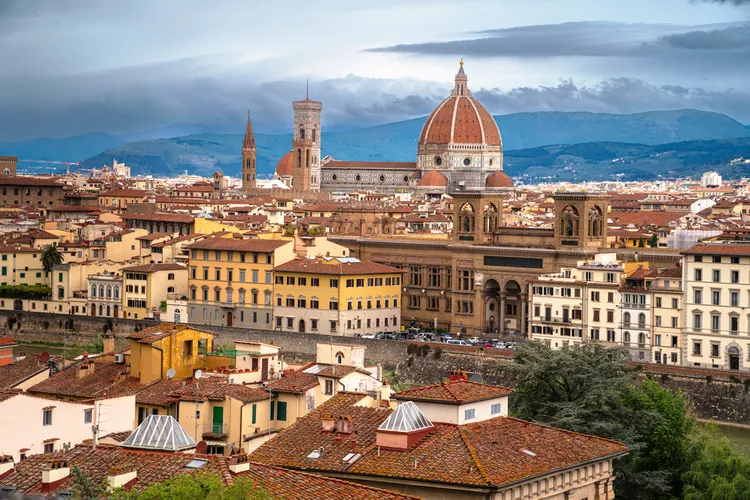Summary
- Leonardo da Vinci-Fiumicino Airport (FCO)
- Ciampino–G.B. Pastine International Airport (CIA)
- Pisa International Airport (PSA)
- Florence Airport, Peretola (FLR)
- Milan Malpensa International Airport (MXP)
- Milan Linate Airport (LIN)
- Orio al Serio International Airport (BGY)
- Naples International Airport
- Venice Marco Polo Airport
The many beautiful cities in Italy are serviced by multiple airports. If you’re flying in from abroad, you’ll likely stop in Rome, Florence, Milan, or Venice before continuing to the smaller cities.
Leonardo da Vinci-Fiumicino Airport (FCO)
- Location: Fiumicino
- Pros: Connects numerous international and domestic destinations
- Cons: Can be overcrowded
- Distance from the Pantheon: A taxi from the airport to downtown Rome costs a flat €48 and takes about 30 minutes without traffic. You can also take the train for €15, which takes just under an hour.
The largest airport serving Rome—and one of the busiest in Europe—is Leonardo da Vinci-Fiumicino Airport, also known simply as Rome Fiumicino Airport. As the hub for Italian airline Alitalia, Fiumicino serves some 43 million passengers annually, connected to Rome’s city center via bus and train, or you can take taxis or rideshares.
Ciampino–G.B. Pastine International Airport (CIA)
- Location: Ciampino
- Pros: Slightly closer to Rome’s city center than FCO; not very crowded
- Cons: Only services low-cost airlines Ryanair and Wizzair
- Distance from the Pantheon: A taxi from the airport to downtown Rome costs a flat €44 and takes about 25 minutes without traffic. You can also take the bus, which costs as little as €4 and takes about an hour.
Rome’s other international airport is the smaller Ciampino G.B. Pastine International Airport. Built in 1916, it primarily serves low-cost airlines but also has many charter and executive flights. It’s connected to Rome via bus service, and you can also take a bus to the nearby Ciampino Railway Station, which offers trains to Rome.
Pisa International Airport (PSA)
- Location: South Pisa
- Pros: Very close to the city center
- Cons: Only services destinations in Europe
- Distance from the Leaning Tower of Pisa: A taxi from the airport to downtown Pisa costs about $15 and takes about 10 minutes without traffic. You can also take the Pisamover, which costs about $3 each way and takes you to the main train station in Pisa in about five minutes, from which you’d take a $2, 15-minute bus ride to the tower.
The main international airport in Tuscany is Pisa International, also called Galileo Galilei Airport. Serving some five million passengers a year, it’s conveniently located only a few miles from Pisa’s city center, just across the Arno River, with excellent public transportation options.
Florence Airport, Peretola (FLR)
- Location: Northwest Florence
- Pros: Very close to the city center
- Cons: Limited flights and destinations
- Distance from the Duomo: A taxi from the airport to downtown Florence costs a flat rate of €20 and takes about 15 minutes without traffic. You can also take a tram for less than $2 or a bus for about $6—both take around 20 minutes.
Florence’s airport serves about two million passengers annually and is the second busiest airport in Tuscany after Pisa. It has limited service compared to Pisa, with primarily Vueling offering flights. Many visitors to Florence fly in via Pisa or take a train from Rome.
Milan Malpensa International Airport (MXP)
- Location: Ferno
- Pros: Serves a wide range of airlines and destinations
- Cons: Far from the city center
- Distance from the Duomo: A taxi from the airport to downtown Milan costs a flat rate of €95 and takes about 45 minutes without traffic. You can also take the Malpensa Express train to the main train station in Milan for about $15 each way (takes approximately 50 minutes).
Milan Malpensa is the largest international airport in the region, located 30 miles outside the city center. It serves surrounding cities in Lombardy and Piedmont, as well as the Swiss canton of Ticino, making it a significant hub for travelers. It is well connected to the city center by bus and train services.
Milan Linate Airport (LIN)
- Location: Segrate
- Pros: Close to the city center
- Cons: Limited service
- Distance from the Duomo: A taxi from the airport to downtown Milan costs a flat rate of €55 and takes about 20 minutes without traffic. You can also take a bus for about $2 each way (takes approximately 30 minutes).
Milan Linate Airport is smaller than MXP but is located just about a mile outside city limits. It has limited service, with only 13 airlines flying to European destinations. Alitalia is the primary operator here, and currently, the only public transportation connection to the airport is via bus.
Orio al Serio International Airport (BGY)
- Location: Orio al Serio
- Pros: Close to Bergamo
- Cons: Far from Milan
- Distance to Milan: A taxi from the airport to downtown Milan costs more than $130 and takes about 50 minutes without traffic. You can also take a bus for about $5 each way (takes approximately one hour).
Known as Il Caravaggio International Airport, Orio al Serio serves both Milan and Bergamo. It facilitates nearly 13 million passengers annually and is the main airport in the region for low-cost airlines. Affordable buses connect the airport with Milan, or you can take a train to Bergamo and then a bus from there.
Naples International Airport
- Location: North Naples
- Pros: Close to the city center
- Cons: No train connections
- Distance to Positano: A taxi from the airport to Positano costs more than €120 and takes about 80 minutes without traffic. Public transportation options are limited—requiring a bus to Sorrento followed by a local bus to Positano.
Naples International Airport, dedicated to Italian aviator Ugo Niutta, serves around 10 million passengers annually. It is the best airport to fly into if you’re visiting Pompeii, the Amalfi coast, or Capri. Since there is no train service to the airport, you can only reach the city by bus or taxi.
Venice Marco Polo Airport
- Location: Orio al Serio
- Pros: Close to Bergamo
- Cons: Far from Milan
- Distance to Milan: A taxi from the airport to downtown Milan costs about $35 and takes about 20 minutes without traffic, while a boat costs around $17 each way.
Venice Marco Polo Airport is one of the busiest in Italy, serving more than 11 million passengers annually. Travelers can connect to local transportation options within Venice and make connections to other parts of Europe. The available transportation options include taxi, private bus, or public boat.




